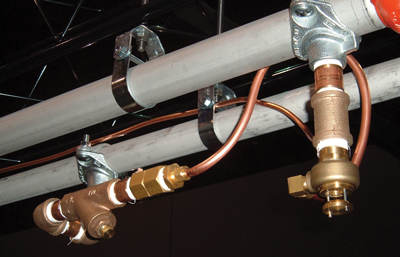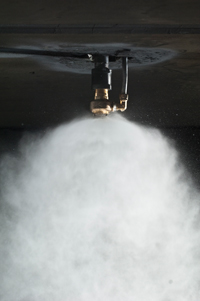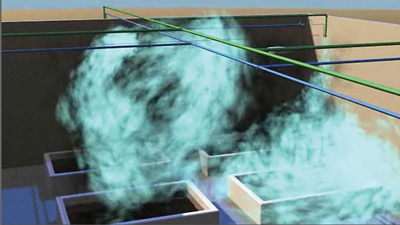| Vortex control panels installed in MCC Room 1. |
By Bob Ballard and Chris Yoder
Following an insurance risk assessment in mid-2012, a preparation plant owned by one of the nation’s largest coal producers sought a fire suppression system for the plant’s motor control center (MCC) and cable spreading rooms. Built in 1978, the West Virginia prep plant is currently fed by two mines and processes a little less than 2 million tons of raw coal per year. The plant’s two MCC rooms and two cable spreading rooms are equipped with a detection-only system that requires human intervention to extinguish a fire, leading the auditor to recommend the installation of a pre-action suppression system to “minimize damage and potential business interruption.”
Water-based sprinklers are a cost-effective fire protection option commonly found in various prep plant areas, but activation of such systems in MCC rooms can cause considerable damage to energized electrical equipment, as well as increase the risk of serious injuries if personnel are present.
If a plant’s water supply is inadequate, the installation of large water tanks and fire-rated pumps can quickly wipe out the potential cost savings of sprinkler systems, which was the case at this plant. The plant does not have a city water connection, and its pumping system did not have enough volume, pressure and capacity to supply a sprinkler system.
Given these hazards and limitations, plant officials asked local contractors to review the application and recommend alternatives for protecting the spaces. Clean agent, dry chemical and hybrid systems were evaluated.
Clean agent fire suppression systems are commonly specified for electrical applications because the chemical or gas the system uses does not harm electronic equipment — a considerable advantage over water-based sprinkler systems.
 |
| The Vortex emitter atomizes water, forming a dense mist. |
Clean agent systems have a few downsides, however, the primary being the requirement for room integrity. For a clean agent system to effectively suppress a fire, the correct concentration of suppressing agent must be maintained in the hazard space. MCC rooms are often not tight enclosures because cable trays and other incoming wiring tend not to be sealed well and could be exposed to the floor below. Conduits running out to the plant also create openings. Sealing MCC rooms to meet specified leak rates can be achieved, but not guaranteed following subsequent modifications (to run wiring to new equipment or devices, for example).
Other disadvantages of clean agent systems vary based on the type of system selected, but include challenges related to pipe size balance, life safety during system activation, and downtime to refill proprietary agents following system discharge.
Dry chemical systems were also considered, as they can be more cost effective than clean agent systems, but proper delivery of the agent is a challenge. The powder particles that such systems utilize must be dispensed directly onto the fire. In the MCC rooms, that would require installing discharge nozzles inside the cabinets.
Another downside of dry chemical systems is that the chemical often does not provide a cooling effect. If a fire reignites following system activation, nothing remains to extinguish the subsequent fire.
That left hybrid systems as the only remaining option. Hybrid systems are a relatively new class of fire suppression; Factory Mutual established the FM 5580 category to classify them in 2009. These systems work by deploying a mixture of water and an inert gas to cool the hazard space, reduce the oxygen content, and generate steam.
System Selection & Configuration
The hybrid system the plant considered — Victaulic Vortex — adequately addressed the prep plant’s concerns regarding the other types of systems: it is not damaging to electrical equipment, it does not require enclosure integrity to effectively suppress a fire, and proper delivery of the agent is not an issue. Another factor was life safety. Installation of the system would not introduce any hazards to personnel present during system activation.
 |
| Close-up of a single emitter during discharge. |
Although the system was more costly than the other fire suppression options considered, the regional vice president made the decision to install Vortex in the MCC and cable spreading rooms, as the system benefits outweighed the costs.
Victaulic Vortex, a hybrid inert gas/water mist system, functions by dispensing a high-velocity, low-pressure mixture of water and nitrogen into the protected space. The emitter atomizes the water using low-pressure nitrogen, forming a dense homogeneous suspension of mist that quickly fills the hazard space in a swirling pattern, enabling it to enter vented-type enclosures such as the cabinets typical of an MCC room. The system does not require room integrity to be effective; fires can be extinguished in open, naturally ventilated areas.
The Vortex system produces water droplets smaller than 10 microns in size, which is up to 100 times smaller than water particles delivered through traditional water mist systems. The small droplet size combined with the minimal amount of water released per emitter — 0.13 to 1.06 gallons per minute depending on emitter size — prevents significant wetting in the space, thereby avoiding damage to electrical equipment. Following discharge, residual moisture is barely detectable.
In the Vortex system, the nitrogen and water mist function as complementary extinguishing agents. Nitrogen is the primary extinguishing agent for smaller fires, reducing the oxygen level in the space to a breathable level where combustion cannot be sustained. In larger fires, the water mist is more effective, cooling the fire by absorbing the heat and reducing the available oxygen. The water droplet surface area is 90 times greater than that of standard sprinkler systems, providing maximum heat absorption efficiency.
By employing only non-toxic agents and maintaining oxygen at levels within safe breathing tolerances, the Vortex system does not pose any life safety hazards; evacuation and discharge delays are not required prior to system activation.
In terms of water supply, potable water can be connected to the system via utility piping, or distilled/deionized water can be used via portable tank. The prep plant installed a 20-gallon tank of distilled water to minimize potential conductivity. Nitrogen is supplied in cylinders or tanks; the plant opted for the former. Based on volumetric calculations of the enclosures, 44 total cylinders were brought in: nine for each cable room, 13 for each MCC room. The number of emitters required is also based on hazard space volume. Each cable room required six emitters, each MCC room required eight. The controls, nitrogen cylinders, water tank and control panels were all installed in one of the MCC rooms.
The prep plant’s system is configured with individual detectors in each room, with zone control panels to isolate activation to the room affected by a fire. Each room is one zone, for a total of four zones.
During the six-week installation period, plant operations were not affected. The system was commissioned in September 2013.
 |
| Animation depicting the swirling pattern of the nitrogen/water mist. |
Although MSHA doesn’t require fire suppression systems for MCC rooms, insurance companies are increasingly recognizing the hazards and pushing plants to install them. In the past, such applications have presented obstacles, but hybrid systems offer promise in their ability to overcome the challenges associated with traditional fire suppression systems. In short, hybrid fire suppression technology provides a safe and effective solution for prep plant MCC rooms.
Bob Ballard is senior project engineer, technical leader, with Victaulic, and Chris Yoder is fire suppression products manager with Pillar Innovations LLC. For more information about the Vortex system, visit www.victaulicvortex.com.




